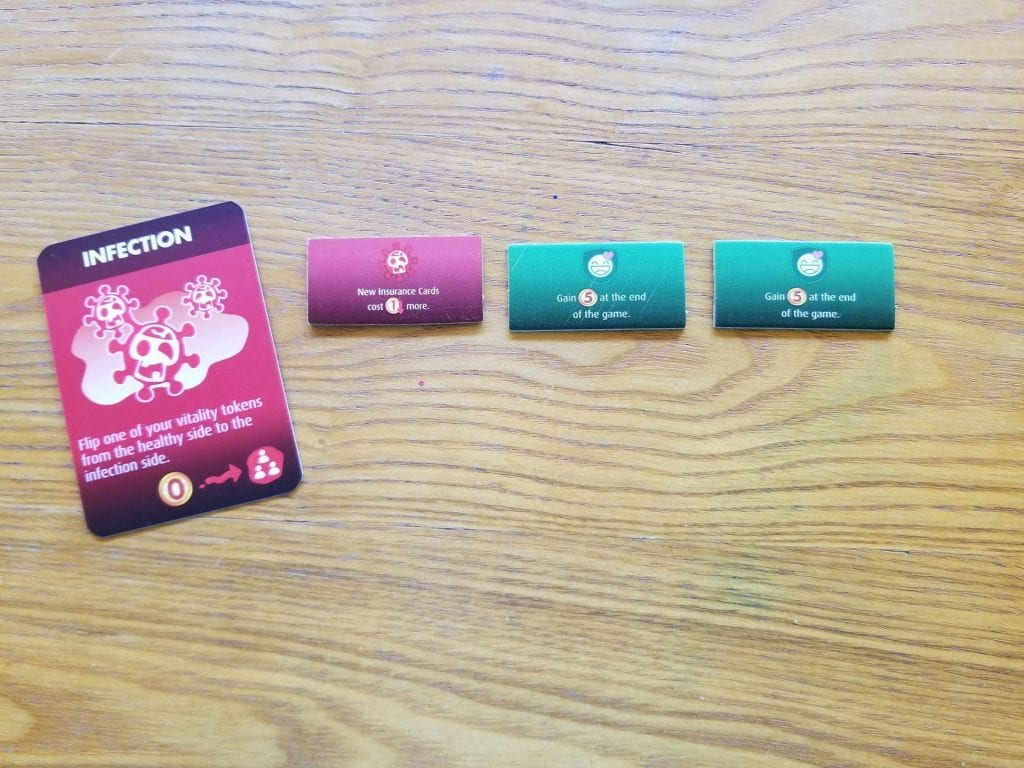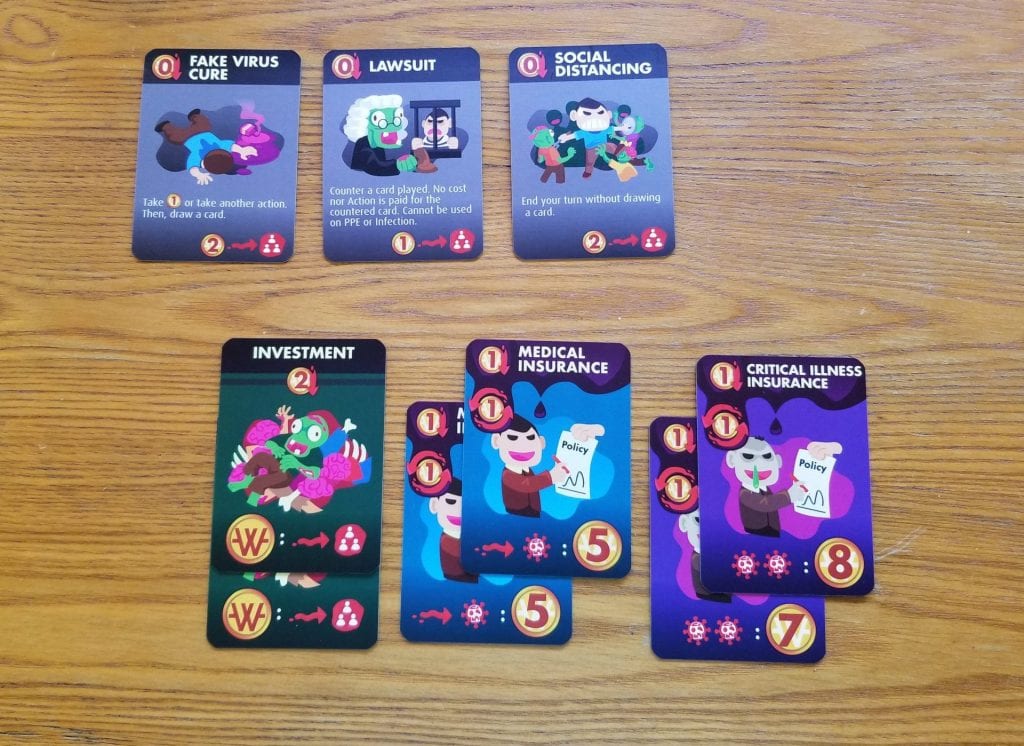Who needs brains when you’ve got money?
Money gets you into places you normally couldn’t get into. Money buys you influence and power. Money can pay for other people to do all the thinking for you. There’s nothing money cannot accomplish.
Well…there’s one thing. Money can’t stop you from turning into a zombie. Once you’re infected there is no cure; you might as well throw in the towel. The trappings of being alive will quickly fade into your rearview and zombie life will be the only life you know. And you know what that means.
Who needs money when you’ve got brains?
Overview
Zombielife Insurance puts the players in the roles of citizens taking out insurance policies covering the various stages of zombification. The longer you can stay alive, the more money you can make over time. However, becoming one of the undead doesn’t have to be an impediment.
During each player’s turn they will have the opportunity to make investments or purchase different insurance policies as well as play Action cards from their hand. These Action cards have many varied effects, but most of them involve some sort of deck manipulation or card drawing. And this is important because the Action card deck is riddled with Infection cards. Draw one of these and you’re that much closer to becoming a full zombie. Whether or not that’s an outcome you’re excited about depends entirely upon the investments you’ve made. Getting infected, even just a little bit, is kind of bad, but cashing out several high-paying insurance policies and making bank as a result removes some of the sting.
Alive or undead, it doesn’t matter: if you’re the player with the most cash at the end of six rounds, you win. This is, of course, a high level overview of Zombielife Insurance. If you’d like to learn how the game is played, continue reading. Otherwise, feel free to skip ahead to the Thoughts section.
Gearing Up
First, separate the different card types into their own decks: Action, Investment, and the four types of Insurance – Endowment, Medical Insurance, Critical Illness Insurance, and Life Insurance. From the Action card deck, remove the Infection cards, the Personal Protective Equipment (PPE) cards, and any cards with printed numbers not matching the player count. Each player receives one PPE card with any remaining being returned to the deck. Shuffle this deck and then deal out three face-down Action cards to each player before adding the Infection cards back to the deck and giving it a thorough shuffle. Leave the deck within reach of the players with room closeby for six side-by-side cards. Each player also receives three wonga (which you might recognize as the currency from Capital Gains Studio’s other efforts suchs as Wongamania and Cryptocurrency), three health tokens flipped to their healthy green side, and a player aid flipped to its Human side (the reverse is the Zombie side).

Next, each type of Insurance and Investment card are laid side by side in their own piles in descending order (where applicable) beginning with the highest valued card on top. Once this is done a starting player is chosen, given the start player token, and you are ready to begin playing Zombielife Insurance.
Life Is All About Taking Risks
Zombielife Insurance is played over the course of six rounds followed by end-of-game scoring. Each round of play is broken down into four steps: collecting salaries and paying insurance premiums, taking actions and/or buying investments or insurance, end-of-turn card draw (and possibly getting infected), and an end-of-round step.
- Collecting Salaries and Paying Insurance Premiums
At the beginning of the round, each player will decide to receive a salary of either two wonga or three wonga. Their choice directly affects the actions they will have available to them in Step 2.

Once the players have received their salary, they then have to pay the upkeep costs of their various investments. Each different Investment card has an upkeep of a single wonga and, with the exception of the Endowment card, the wonga paid are returned to the bank. Any Insurance cards that you cannot or do not wish to pay for are discarded. The money paid for the Endowment card is placed directly on top of the card where it will accumulate (more about Insurance cards later).
- Taking Actions and/or Buying Investments or Insurance
Depending on the salary the player decided to take in Step 1, they will:
Two wonga salary received – perform two actions and then draw a card.
Three wonga salary received – perform no actions and then draw a card.
If the player chooses the first option, then the actions they can choose from are either buying insurance policies and/or investments by paying their cost and then placing the newly acquired cards face up in their player area OR playing an action card from their hand by paying its cost and performing the associated action.
- End-Of-Turn Card Draw (and Possibly Getting Infected)
Regardless of which option is chosen in the previous step, it will always end with the player drawing a card and adding it to their hand. That is, unless the drawn card is an Infection card.

If the player draws an Infection card, then they must flip one of their health tokens over to its red side. Depending on how much damage the player has already taken, this may cause an Insurance card to pay out (more on this later). Then the player secretly slots the Infection card back into the deck anywhere they choose without changing the order of the cards.
Getting infected also causes future Insurance cards to become more expensive – one extra wonga per flipped health token.
- End-of-Round Step
At the end of a round, the last player will draw a card from the Action deck and place it face up into the Round Indicator Area (the area set aside for the six cards earlier). Then the players will count up their total number of Investment cards, multiply that total by whatever number shows up at the bottom of the revealed Action card, and collect that many wonga. Actions cards vary in value from one to three, but it’s just as likely a zero value Infection card will be revealed and players won’t earn anything at all. Players certainly won’t earn anything if they don’t possess any Investment cards. Then the first player marker gets passed to the next player.

Congratulations on Your New Life As a Dead Person
If you happened to flip over your last green health token during step 3, then all of your applicable Insurance cards are automatically cashed out. Any that cannot be cashed out are discarded along with your hand of Action cards, and your player aid is flipped to its Zombie side.
So you’re a zombie. Now what?
Some would argue that life really begins when you die. Just because you’re a zombie doesn’t mean you’re out of the game. On your turn you’ll have three options available to you: peek at the top two cards of the deck and put them back in any order, force a player to discard two cards at random, or peek at the top four cards of the deck and remove one of them from play entirely.
Living Your Best Life: Investments and Insurance
Investment and Insurance cards are the bread and butter of Zombielife Insurance. Most of the money that you’ll earn during the course of the game is going to come from some combination of these. Of the two, Investments are the easiest to absorb. An Investment card costs you two wonga to acquire and sits in front of you for the remainder of the game (or until you become a zombie) and is used during the salary step to determine just how much money you’ll earn.

Insurance cards, though, require a bit more explanation. As mentioned earlier, there are four types: Endowment, Medical Insurance, Critical Illness Insurance, and Life Insurance. Medical, Critical Illness, and Life Insurance work in pretty much the same way, awarding you with wonga when you receive a total of one, two, or three wounds respectively. You can only purchase Critical Illness Insurance with no more than a single wound and Life Insurance with no more than two. Medical Insurance can be acquired once a player has zero, one, or two wounds (since each payout triggers as soon as the required number of wounds are accumulated).
Endowment was talked about earlier. Other than what was already mentioned, it is important to note that if a player manages to survive until the end of the game, the Endowment becomes worth two wonga plus twice the amount of wonga that has accumulated on top of it. However, a zombiefied player will earn at least two wonga from it before it is removed.
Taking Measures: The Action Cards
Without going into a lot of detail, Action cards provide the players with various game-changing abilities such as allowing the player to rearrange the top few cards of the deck or skip drawing a card at the end of their turn. Each of these cards has a cost to play (in wonga) at the top left of the card as well as the salary step value printed at the bottom of the card.
Consider the following example:

The Fake News Action card costs zero wonga to play and allows the player to place an Action card from their hand back into the Action card deck at a position of their choosing. If Fake News is flipped during the salary step, it will be worth one wonga times the number of each player’s Investment cards.
The End Game
The game ends after six rounds. Each player receives five wonga for each leftover green health token they have and any remaining Endowment cards are cashed out. The player with the most money wins the game.
Thoughts
Zombielife Insurance is one of those games that has you scratching your head as you’re poring over the rules wondering “What’s the point?” It’s one of those games that seems really dry on paper; without a lot of meat on its bones. As I read over the rules the first time, I was fully prepared for an oncoming let down. I was steeling myself for the sobering possibility that Capital Gains Studio had finally done me wrong. But I’d made a commitment to write a review, so I gamely played on.
So there I was after four rounds of my very first game with two Investment cards, three Critical Health insurance cards, and one wound to my name. That’s when it occurred to me that, with time running out, I REALLY wanted to get infected again. But there was a problem. Two of the Infection cards were already sitting in the Round Indicator Area. With only eight of them in the entire deck, having two of them sitting out like that drastically reduced the likelihood of me drawing another one. In my hand I was holding a Fake Virus Cure (which allows you to draw an extra card during your turn), a PPE (which can prevent the effects of an Infection card), and an Expert Advice (which allows you to rearrange the order of the top three cards of the deck).
I realized that I could theoretically stack the deck at this point and guarantee myself the draw that I wanted (provided there was an Infection within those top three cards) and I was about to do so when another thought occurred to me. If I could stack the deck in my favor this round, I could just as easily do the same thing during the next one. That would allow me to double down on Critical Illness insurance for an even higher payout when I took my second wound. But there was no guarantee that the Infection cards weren’t all at the bottom of the deck. As I sat there agonizing over which move to make, that’s when I realized how brilliant this game is.
The insurance game is, by definition, a gamble. Insurance companies gladly take your money each month and cross their fingers hoping that you will never need to call on them. And that’s what everything feels like in Zombielife Insurance. There’s always the risk that those Endowments you invested in heavily early in the game aren’t going to produce any returns. There’s always the risk of the next card you draw being the one that sends you into full zombiehood. So you’re challenged with having to figure out how to prepare for every eventuality with a very small timeframe in which to do so.
Zombielife Insurance is a clever puzzle packed with tight decisions. I will confess that, because of the current pandemic state we live in, I have only ever played the game at the two-player count, but it handles two players extremely well. There are a few cards in the deck that seem a lot less useful than others, but having played several times now, I will say that I have found uses for every last card in the deck at one point or another, whether it was trying to get myself infected sooner or trying to hamper my opponent’s efforts in some way. One of the game’s best selling points is its quick play time. Zombielife Insurance is a game that I can set up, play, and put away during my lunch break and there’s a lot to like about that.
There isn’t much not to like about the game, in fact. The only issues I’ve had thus far are questions that have come up during gameplay that have stemmed from some rulebook oddities. Let’s just say, this rule book needs some work. But Xeo Lye’s a great guy and has been quick to answer all of the questions I’ve had and my interactions with him and Capital Gains Studio in the past have shown me that he takes criticism to heart. Every time that I have raised a concern or asked for clarification on a point, those concerns have been addressed in the rules. I have no doubt that will be the case here.
I have enjoyed my time with Zombielife Insurance and I think you will, too. Unless you own one of the insurance companies that have produced these policies.











Add Comment